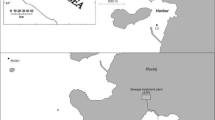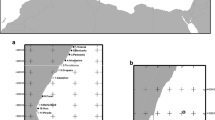Abstract
A study to determine the impact of seafood packing and processing effluents discharged to southeastern estuarine waters was conducted in July and August of 1979. The environmental impact of current seafood processing wastes on Georgia’s estuaries appears to be minimal when compared with the natural organic load. One large estuary demonstrated a high residual capacity to receive processing effluents without significant change. The BOD load from shrimp thawing, peeling, sorting, and cleaning operations at a large seafood processing plant was shown to be equivalent to the organic material generated by a 302 m2 plot (57 ft×57 ft) of salt marsh. NH4−N levels were greater than, but the same order of magnitude as, natural runoff from marsh land.
Similar content being viewed by others
Literature cited
American Public Health Association. 1976. Standard Methods for the Examination of Water and Wastewater, Fourteenth Edition. American Public Health Assoc., Washington, D.C. p. 441–447, 132–134, 553–554.
Association of Official Analytical Chemists. 1975. Official Methods of Analyses of the Association of Official Analytical Chemists. Association of Official Analytical Chemists, Washington, D.C. p. 606.
Bower, C. E., and J. P. Bidwell. 1978. Ionization of ammonia in seawater, effects of temperature, pH, and salinity. J. Fish. Res. Board Can. 35:1012–1016.
Brunswick Junior College. 1977. Water Quality Investigation of Estuaries of Georgia 1976. Environmental Protection Division Georgia Department of Natural Resources. Atlanta, GA. 116 p.
Food and Drug Administration. 1978. Bacteriological Analytical Manual. Association of Official Analytical Chemists, Washington, D.C. p. IV-1 to IV-10, V-1 to V-6.
Georgia Department of Natural Resources. 1974. Rules and Regulations for Water Quality Control. Chapter 391-3-6 revised June, 1974. Georgia Environmental Protection Division, Atlanta, GA. p. 701–731.
Georgia Environmental Protection Division. 1976. Brunswick Estuary Study. Georgia Environmental Protection Division Department of Natural Resources, Atlanta, GA, 52 p.
Haines, E. B. 1979. Nitrogen pools in Georgia coastal waters. Estuaries 2:34–39.
Ho, C. L., and B. B. Barrett. 1975. Distribution of nutrients in Louisiana’s coastal waters influenced by the Mississippi River. Louisiana Wildlife and Fisheries Commission Oysters, Water Bottoms, and Seafood Division Technical Bulletin No. 17:1–39.
Houser, L. S. 1965. National Shellfish Sanitation Program Manual of Operations, Part 1, Sanitation of Shellfish Growing Areas. U.S. Department of Health, Education and Welfare, Public Health Service, Washington, D.C. 32 p.
Martin, D. F. 1972. Marine Chemistry, Volume I, Analytical Methods. Marcel Dekker, Inc., New York. p. 148–152.
Reimold, R. J., W. A. Bough, and M. A. Hardisky. 1976. dissolved oxygen and biochemical oxygen demand in the Brunswick Estuary and King Shrimp Company, Inc. process effluent. University of Georgia Marine Resources Extension Center. Brunswick, GA. 26 p.
Reimold, R. J., J. L. Gallagher, R. A. Linthurst, and W. J. Pfeiffer 1975. Detritus production in coastal Georgia salt marshes, p. 217–228. In Estuarine Research, Vol. I, Chemistry, Biology and the Estuarine System. Academic Press, Inc., New York.
Remington, R. D., and M. A. Schork. 1970. Statistics with Applications to the Biological and Health Sciences. Prentice-Hall, Inc., Englewood Cliffs, N.J. p. 288–301.
Schefler, W. C. 1969. Statistics for the Biological Sciences, Addison-Wesley Publishing Co., Reading, Massachusetts. p. 104–119.
Schleper, C. 1972. Research Methods in Marine Biology. University of Washington Press, Seattle, Washington. p. 281–289.
Scott, P. M., M. D. Wright, and W. A. Bough. 1978. Characterization of waste loading from a shrimp packing house and evaluation of different screen sizes for removal of heads, p. 214–224. In Ranzell Nickelson (ed.), Proceedings of the Third Annual Tropical and Subtropical Fisheries Conference of the Americas. Texas A&M University, College Station, Texas.
Stickney, R. T., and D. Miller. 1973. Chemical and biological survey of the Savannah River adjacent to Elba Island. Technical Report Series Number 73-3. Skidaway Institute of Oceanography, Savannah, GA p. 68.
U.S. Environmental Protection Agency. 1976. Methods for Chemical Analysis of Water and Wastes. U.S. Environmental Protection Agency. Cincinnati, Ohio. p. 11–12, 249–265.
Wise, J. P., and B. G. Thompson. 1977. Fisheries of the United States, 1976. U.S. Department of Commerce, NOAA, Washington, D.C. p. 96.
Author information
Authors and Affiliations
Rights and permissions
About this article
Cite this article
Gates, K.W., Perkins, B.E., EuDaly, J.G. et al. The impact of discharges from seafood processing on southeastern estuaries. Estuaries 8, 244–251 (1985). https://doi.org/10.2307/1352205
Received:
Accepted:
Issue Date:
DOI: https://doi.org/10.2307/1352205




